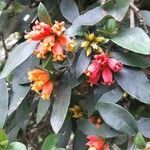Capitulis terminalibus pedunculatis, foliis oblongis integerrimis glabris. Folia opposita, breve petiolata, oblonga, venofa. Pedunculus ramulum terminans, folitarius, multiflorus: floribus in capitulum aggregatis, fessilibus. Capitulum cinctum involucro polyphyllo, brevissimo, quadris fexfloro. Calyx monophyllus, hirtus, quinquedentatus: dentibus fubulatis, recurvis. Corollae tubulofae, calyce longiores, figura Symphyti, hirtae, quinquedentatae. Capsula bilocularis, calyce permanente coronata.
A shrub or small tree. It grows about 3 m high. It has a few hairs. The leaves are opposite and leathery. The leaf blade is oval and blunt. It narrows to the base. The base can sometimes be slightly heart shaped. The leaves are 15 cm long by 6 cm wide. The flowers are in a cluster at the ends of the branches. The flowers are tube shaped and orange-red. The fruit is fleshy with many seeds. The fruit are 1.5 cm across.
Small tree, 3.6-4.2 m high. Leaves 105 x 55 mm, broadly ovate, rounded or subcordate at base, pubescent on veins beneath, petiolate. Inflorescence terminal, many-flowered. Fruit a subglobose berry crowned with persistent calyx lobes. Flowers bright red or orange.
Shrub or small tree to 5 m. Leaves opposite, elliptic, glossy above, margins revolute. Flowers few in terminal heads, tubular, velvety, orange.


